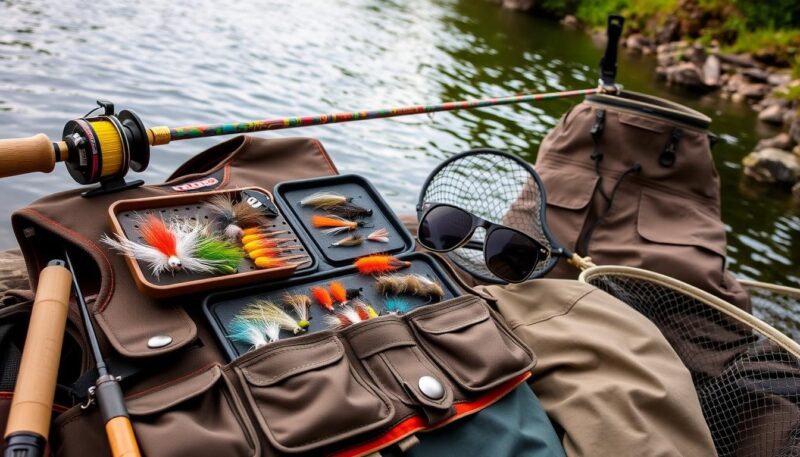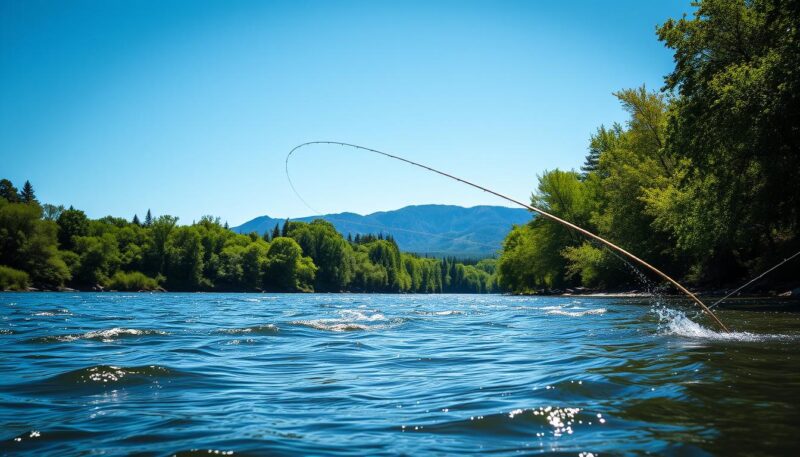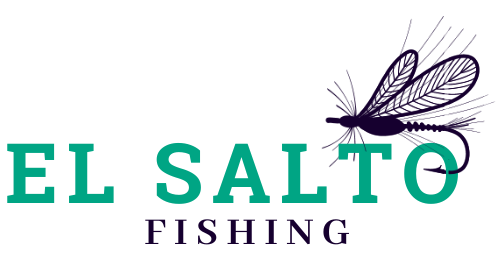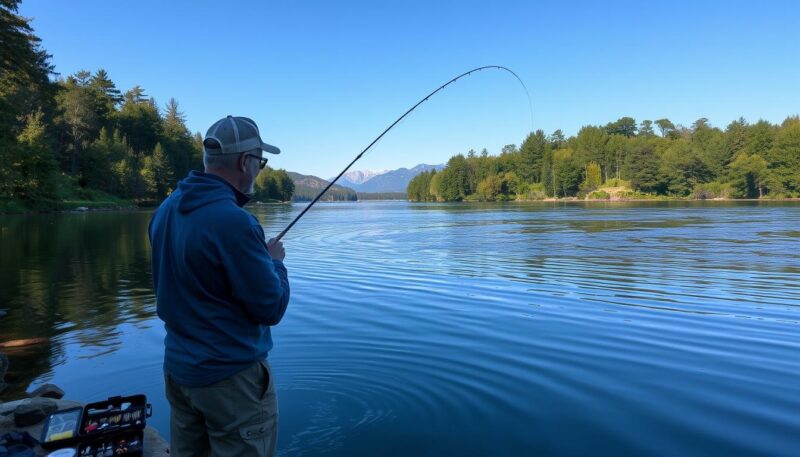Embarking on the journey of fly fishing can be both exciting and daunting for beginners. This captivating outdoor activity not only offers an escape into nature but also a rewarding way to connect with the environment. However, many feel overwhelmed by the wealth of equipment, techniques, and terminology that comes with it. In this beginner fly fishing guide, you’ll acquire the foundational knowledge necessary to thrive as an angler. Understanding that fly fishing involves casting artificial lures, known as “flies,” will help demystify the process. These flies aim to mimic various prey species, enticing the fish as they are cast onto the water surface or submerged below.
Your success and enjoyment largely hinge on familiarizing yourself with essential gear, honing your techniques, and maybe even mastering some local fishing spots. Quality gear plays a crucial role in performance and casting success, showing a direct correlation between what you use and how well you catch fish. Local fly shops can be invaluable resources, providing you with insights on the best practices and local waters that can significantly enhance your catch rates—research indicates that informed anglers can improve their success by up to 30%!
Moreover, practicing the fundamental skills of casting in a safe area, such as your backyard, can make a world of difference. Many beginners report increased comfort when casting after only 1 to 2 hours of practice, bolstering confidence and readiness for actual fishing trips. In this piece, you’ll learn everything you need to know to get started with fly fishing and tackle the challenges that come with it. Let’s dive into this thrilling hobby, ensuring you’re well-equipped for your adventurous outings.
Getting Started with Fly Fishing Basics
Understanding the essence of fly fishing is essential before you start your journey. This unique method revolves around precision casting with lightweight flies, allowing for a more delicate interaction with fish. Matching your fly to the local insect activity requires observation and skill, making learning fly fishing an engaging challenge. You may find that the natural surroundings aid in capturing your interest, offering both tranquility and excitement as you explore this captivating activity.
Understanding Fly Fishing: What Makes It Unique?
Fly fishing stands apart from other fishing methods due to its reliance on the fly’s presentation and technique. Rather than relying solely on bait, fly anglers use artificial flies that mimic the insects fish are feeding on. The capture process involves gracefully casting a fly with a flexible rod and specialized line, allowing you to connect with nature in a unique way. As you progress, these fly fishing basics will form the foundation of your skills, enhancing your overall experience.
Fly Fishing Lingo: Key Terms You Should Know
Familiarizing yourself with crucial fly fishing terms is a key step in your learning journey. Here are some fundamental terms you may encounter:
| Term | Definition |
|---|---|
| Dry Fly | A fly that floats on the surface of the water. |
| Nymph | A stage in an insect’s life cycle, often fished below the surface. |
| Tippet | The thin line connecting the fly to the leader. |
| Leader | A section of line that connects the fly line to the fly. |
| Strike Indicator | A tool used to signal when a fish is biting. |
| Backing | A line that connects the spool to the fly line, providing extra length. |
Grasping these terms will empower you to adapt to conversations among your peers and navigate your way through local fly shops. Embracing these fly fishing tips and terminologies will improve your confidence and knowledge as you venture deeper into this exhilarating sport.
Fly Fishing Gear for Beginners
Embarking on your fly fishing journey requires the right fly fishing gear for beginners to ensure a successful experience. Selecting the proper equipment can enhance your enjoyment and productivity while out on the water. The essentials for your first fly fishing trip typically include a quality fly rod, reel, line, and a variety of flies.
Essential Equipment for Your First Fly Fishing Trip
Your essential gear will aid in both comfort and effectiveness when fishing. A standard setup for beginners usually consists of:
- A 9-foot 5-weight fly rod, which offers versatility across multiple freshwater fishing scenarios.
- A matching fly reel, with a preference for large arbor designs for more efficient line retrieval.
- Fly fishing lines, ideally a weight-forward floating line to support easier casting and presentation.
- A selection of flies to attract different fish species, such as dry flies, wet flies, streamers, and poppers.
- Waders and wading boots for safety and comfort, helping you navigate slippery riverbanks.
- A fly fishing vest to organize and store various gear items.
Choosing the Best Fly Rod and Reel for Beginners
When considering the best fly rods for beginners, prioritize a rod classified as medium action. This balance provides better control and responsiveness. You can easily find rods ranging from 00 to 16 weights, but starting with a 5-weight rod is often advisable. Pair this with a 5-weight reel, ensuring they match for optimal performance. Large arbor reels are particularly useful, offering a higher line retrieval rate compared to their small arbor counterparts.
Understanding Fly Lines and Their Importance
Fly fishing lines vary in weight and play a crucial role in your casting and fishing success. Ranging from 1 to 14 grains, the weight of the line can significantly impact your casting precision and control. A weight-forward floating line is recommended for beginners, as it allows for effective casting and helps deliver the fly accurately to the target area. Investing in good quality fly lines can simplify your learning process and increase your future success.

Fly Fishing Techniques and Tips
Mastering specific techniques is crucial for success in fly fishing. Focus on perfecting your fly fishing casting techniques, which lays the groundwork for effective presentations. Consistent practice in open spaces builds your confidence. Pay attention to your stance and smooth arm motion to achieve controlled casts. The quality of your casting can significantly affect your ability to reach targeted spots where fish may be hiding.
Basic Fly Fishing Casting Techniques
Effective casting starts with understanding various styles that suit different fishing scenarios. Here are some methods to incorporate into your practice:
- Roll Cast: Useful for short distances and tight spaces.
- Overhead Cast: Ideal for open water, allowing for longer casts.
- Sidearm Cast: Great for casting under trees or other structures.
- Double Haul: A technique for added distance that combines a pull on the line while casting.
Essential Fly Fishing Knots You Need to Learn
Understanding fly fishing knots is just as important as mastering casting. Securely attaching your flies can make the difference between landing a catch or losing one. The following knots are crucial:
| Type of Knot | Purpose |
|---|---|
| Improved Clinch Knot | Connects the fly to the tippet line. |
| Loop Knot | Provides movement for streamers and wet flies. |
| Braid Knot | Links braided lines to a leader. |
| Blood Knot | Joins two lines together for larger rigs. |
Best Practices for Catching Trout While Fly Fishing
When you venture out for fly fishing for trout, knowing where to cast is essential. Trout often feed subsurface, with approximately 80-90% of their diet consisting of nymphs and larval forms. Consider these strategies to increase your chances of success:
- Fish near seams and structures where food sources gather.
- Observe trout behavior; they typically hang near the river bottom.
- Use heavier flies for deeper pools, especially when the water is murky.
- Regularly check local hatch charts for seasonal insect activity to match your fly selection.

Pay attention to handling techniques, especially if practicing catch and release. Wet your hands before touching trout to prevent damaging their skin and gills. These practices not only promote better fishing outcomes but also ensure the sustainability of trout populations for future anglers.
Conclusion
Embracing fly fishing can lead to a deeply rewarding experience, allowing you to connect with the beauty of nature while honing your skills. By understanding the essential gear, such as the versatility of a 5-weight rod for trout in rivers and lakes, you pave the way to becoming a proficient angler. Many beginners often choose basic setups with plans to upgrade as they gain confidence, and adopting best practices for fly fishing will help you improve your technique over time.
As you embark on this journey, patience is vital. You may not catch fish on your first day, but each outing allows you to refine your casting techniques, explore different types of flies, and learn the intricacies of reading water. Engaging with local fly fishing clubs and utilizing apps like onWater can enrich your understanding and provide insights regarding fishing spots and conditions.
Ultimately, the joy of fly fishing lies in the journey itself. From the thrill of your first catch to the tranquil moments spent casting your line, every experience contributes to your growth. With dedication and the implementation of effective fly fishing tips, you are sure to cultivate not only a passion for the sport but also unforgettable memories in the great outdoors.

